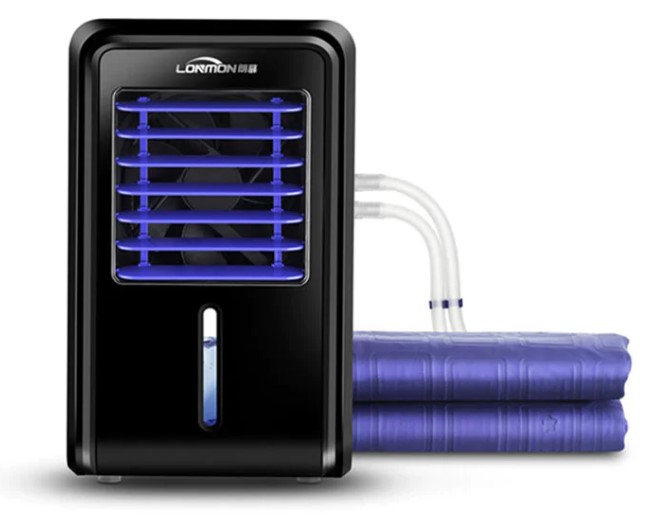Structural composition of water-cooled mattress
Water-cooled mattresses are usually composed of multiple structural parts, including surface fabric, water circulation channel, connecting hose, temperature control host and control system. Among them, flexible water pipes are built into the mattress body to form a closed circulation loop, and the temperature control host forms a circulation system with the water channel inside the mattress through the connecting hose. The control system generally integrates temperature regulation function, and the parameters can be set through the panel or remote control. This structural design can not only regulate the temperature of the bed surface, but also ensure that the mattress has a certain softness and support.
Working principle of water circulation system
The water-cooled mattress heats or cools the water through the temperature control host, and then drives the pump to inject the regulated water into the water pipe system inside the mattress for circulation. Cold water or hot water flows in the mattress and is evenly distributed under the human body contact surface to achieve temperature conduction. Using the high specific heat capacity of water, the mattress can maintain a stable temperature state for a long time. Through continuous circulation, the mattress can play a cooling role in hot environments and provide warming support in cold seasons.
Implementation method of temperature regulation
Currently, water-cooled mattresses on the market generally use compressor refrigeration, semiconductor (TEC) refrigeration or heat exchange system for temperature regulation. The compressor refrigeration system is more efficient and suitable for large-area mattresses; while the TEC semiconductor refrigeration system is smaller in size and has lower operating noise, which is suitable for personal mattresses. Some products provide a temperature setting range, such as 16°C to 40°C, and the water temperature is automatically adjusted by the thermostat to ensure a constant temperature on the surface of the mattress, reducing the discomfort caused by temperature differences during sleep.

Temperature control stability
Due to its continuous water circulation mechanism, the water-cooled mattress can quickly respond to changes in ambient temperature and achieve constant temperature output. Compared with electric blankets or air-cooled mattresses, its temperature control response is smoother, avoiding night awakening or skin irritation caused by temperature fluctuations. At the same time, because water is a heat transfer medium, it has good temperature buffering properties and is not prone to instantaneous overheating or overcooling, thereby improving the comfort of sleep.
Energy consumption level analysis
Depending on the heating and cooling methods of different water-cooled mattresses, their power is usually between 30W and 150W. Products with higher power ranges are suitable for double beds or extreme climate environments, while energy-saving products are controlled at low energy consumption levels and are suitable for use under daily climate conditions. Compared with traditional air conditioners, water-cooled mattresses consume much less energy than the overall room refrigeration equipment, especially in zoned temperature control and nighttime use scenarios, and have certain energy-saving advantages.
Noise control level
The noise sources of water-cooled mattresses mainly include water pumps, fans (if any) and compressors. Some mid-to-high-end products effectively control the operating noise below 35dB through silent water pumps, vibration-damping pad design and sound insulation structure, which is lower than the general air conditioner operation sound. Low noise helps to ensure the quality of users' sleep at night, and they will not wake up frequently due to continuous sound interference.
Safety and service life
Due to its water-electricity separation design, water-cooled mattresses have certain advantages in safety. The water pipe material is usually made of pressure-resistant materials such as TPU and PE. The internal water flow pressure and temperature are controlled by the host, and they can automatically power off or alarm in case of abnormalities. At the same time, most hosts have safety functions such as water leakage protection, over-temperature protection, and dry burning protection. For long-term use scenarios, its service life can reach 3 to 5 years. It should be noted that the water system should be cleaned regularly to prevent blockage or microbial growth.
Surface material and human body contact comfort
Common materials for the surface of water-cooled mattresses include knitted cotton, polyester blended fabrics, TPU composite materials, etc. These materials are both soft and breathable, ensuring that the human body does not feel stuffy when in direct contact, and have high water resistance and antibacterial properties. Some products are environmentally friendly and do not contain fluorescent agents, formaldehyde and other harmful substances, suitable for sensitive people or infants.
Market product parameter comparison
The following table shows the parameter comparison of several typical water-cooled mattresses in terms of temperature control range, energy consumption, noise control and applicable bed types:
| Model | Temperature Range (°C) | Power (W) | Noise Level (dB) | Applicable Bed Type | Circulation System Type |
|---|---|---|---|---|---|
| Model A | 20–38 | 90 | ≤38 | Single bed | Compressor Cooling Cycle |
| Model B | 16–40 | 120 | ≤36 | Double bed | Compressor Cooling Cycle |
| Model C | 18–35 | 50 | ≤35 | Single bed | TEC Semiconductor Cooling |
| Model D | 22–39 | 60 | ≤37 | Single or Double bed | Heat Exchange Circulation |

 英语
英语 中文简体
中文简体









